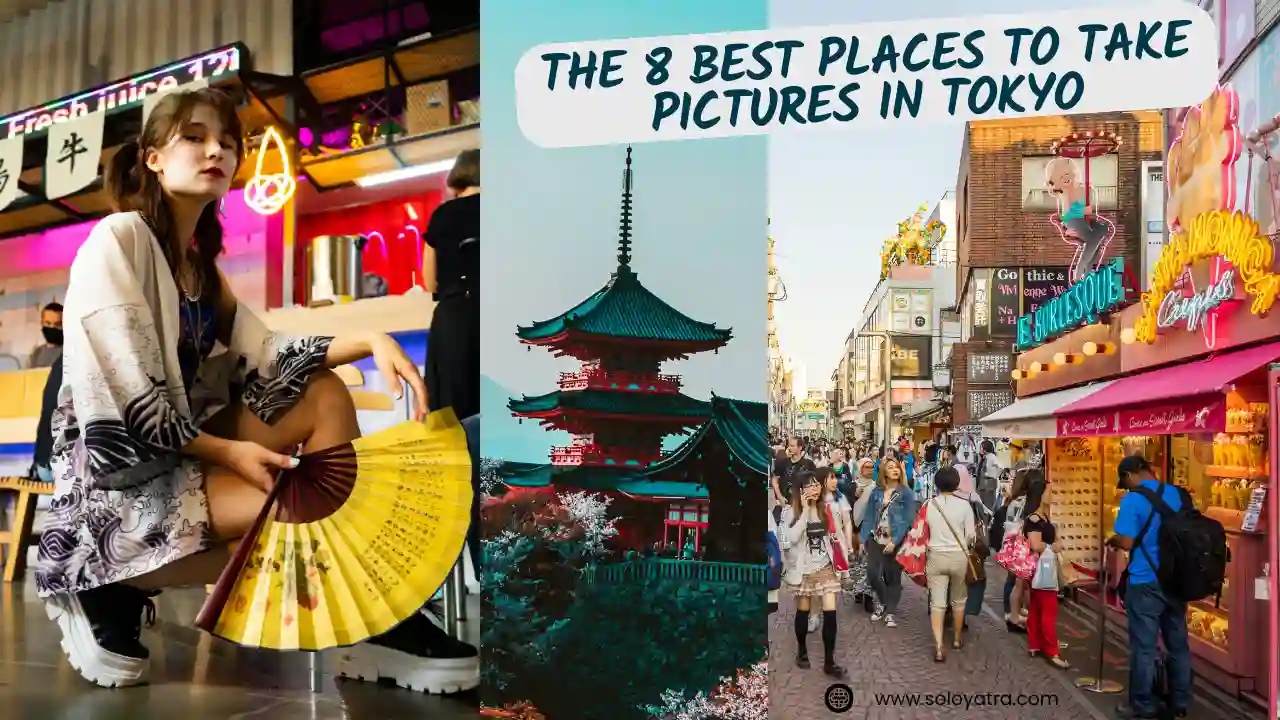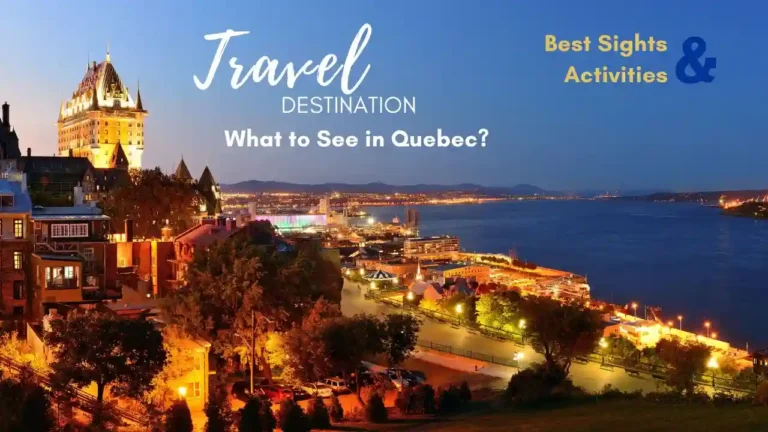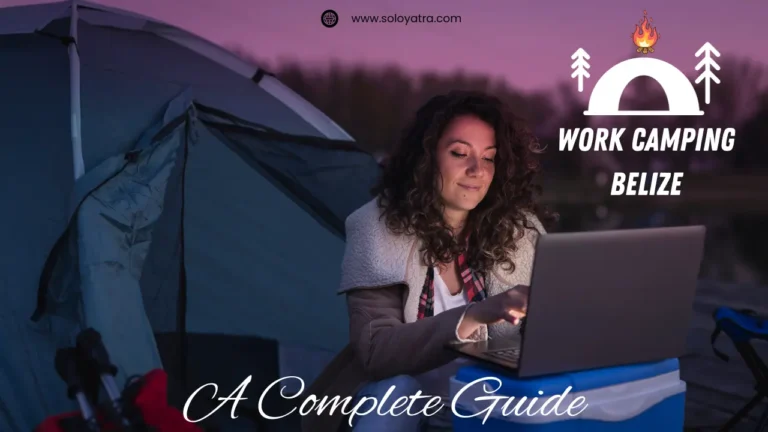The 8 Best Places to Take Pictures in Tokyo: A Photographer’s Guide
Introduction
Tokyo is a photographer’s paradise, bursting with stunning cityscapes, historic sights, futuristic architecture, and fascinating culture around every corner. As a professional travel photographer who has visited Tokyo many times, I’m often asked – where are the best places to take pictures in this sprawling metropolis?
After much exploration, I’ve narrowed down the top photography spots in Tokyo that provide amazing photo opportunities for travelers. From the dazzling neon lights of Shibuya to the tranquil gardens of the Imperial Palace, this list has something to offer every photographer.
In this extensive Tokyo photography guide, I’ll provide the best places to take photos in Tokyo with insider tips on getting to each location, the best times to visit, and how to compose stunning shots. You’ll find precise recommendations on gear, camera settings, and perspectives to capture Tokyo’s vibrant energy and traditional beauty. Whether you’re a pro looking for new inspiration or just want great Instagram pics, read on for the ultimate list of the top 8 places to photograph in Tokyo, enriched with valuable Tokyo photography tips.
Let’s explore the best photo spot in Tokyo in this adventurous guide.
Do read the People Also Ask (FAQs) about this topic.
The 8 Best Places to Take Pictures in Tokyo
- Shibuya Crossing
- Meiji Jingu Shrine
- Tokyo Skytree
- Senso-ji Temple
- Tokyo Imperial Palace
- Odaiba Waterfront
- Yoyogi Park
- Takeshita Street
Spot 1: Shibuya Crossing
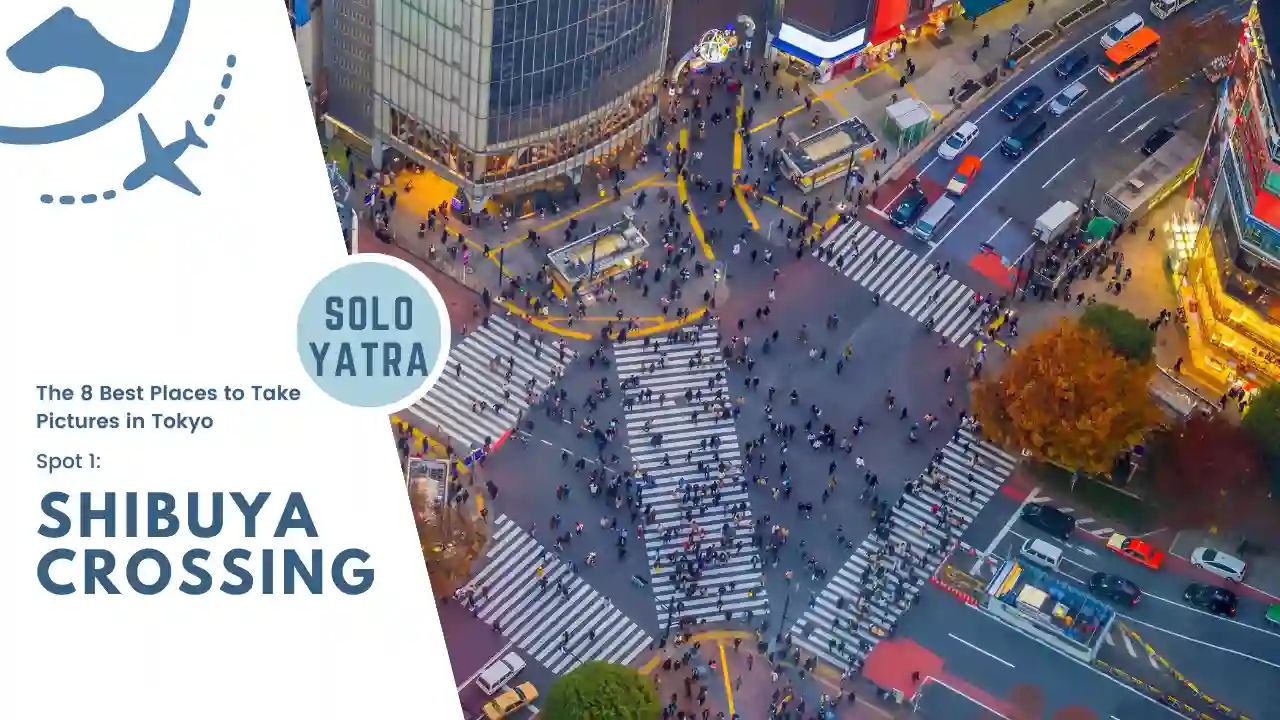
The first must-visit Tokyo photography spot on this list is the iconic Shibuya Crossing. Located in front of Shibuya Station, it’s one of the world’s busiest pedestrian crosswalks. Up to 2,500 people cross at a time, resulting in an intense choreography of people and movement.
To capture the scale and energy of the crossing, I recommend shooting from the second floor of the Starbucks across the street. It overlooks the intersection and provides an elevated view. Go in the early evening when commuters are pouring out of the station at rush hour.
Set your shutter speed to 1/125th sec to freeze the action and your aperture around f/8 for sharp focus. A wide-angle lens like 16–35mm captures the expansive scene. Try both horizontal and vertical compositions.
For a street-level perspective, position yourself near the green light at the corner. Shoot people as they stream past in orderly lines, their blurred forms juxtaposed against the rigid geometry of the zebra crossing. A fast prime lens like 50mm f/1.8 conveys a sense of motion.
Don’t forget to take portraits of pedestrians too. Catch their expressions as they navigate this choreographed chaos. Shibuya Crossing may be Tokyo’s most photographed spot but with good reason. There are endless ways to capture its kinetic energy. This is one of the many Tokyo photo spots that offer a unique perspective of the city’s vibrant energy.
Best For: Best for capturing the energy of urban life and night cityscapes.
Best Time to Visit
Shibuya Crossing is a spectacle at any time of the day, but it truly comes alive during the city’s rush hours. This is when you can witness the iconic sea of people crossing the intersection simultaneously.
For a different perspective, consider visiting at night when the city lights add a vibrant backdrop to the bustling scene.
Best View
The best way to capture the energy of Shibuya Crossing is from an elevated point. An ideal spot is a nearby building that overlooks the intersection, allowing you to capture the choreography of people and movement.
For a more immersive experience, try shooting from street level. Position yourself near the corner of the intersection to capture the orderly lines of people streaming past against the backdrop of the city.
Pro Tips
When photographing Shibuya Crossing, consider using a wide-angle lens to capture the expansive scene. Experiment with both horizontal and vertical compositions to add variety to your shots.
Spot 2: Meiji Jingu Shrine

In bustling Tokyo, the sprawling grounds of Meiji Jingu Shrine provide an oasis of spiritual calm. The shrine’s signature towering torii gate, forested paths, and ornate buildings create a tranquil scene far removed from the city.
To photograph the grounds, I recommend starting at the main torii gate. Frame it front and center to emphasize its height and symmetry. Shoot from the middle of the path so the rows of trees converge dynamically toward the gate. A wide-angle lens captures the expansive scale.
Next, stroll along the forested paths to photograph the small shrines and offerings along the way. Use a telephoto lens around 85mm-135mm to isolate intimate details like ema plaques or sake barrels. Seek out unique perspectives like shooting through the gaps in fences or foregrounding small statues.
When you reach the inner shrine area, the main building’s sharp angles and intricate details make striking photos. Try upward angles to emphasize the sloped roof lines against the sky. A polarizing filter boosts contrast for added drama.
Aim to visit in the quiet morning hours when crowds are minimal. The tranquility conveys the spiritual power of this oasis in the city, making it a must-visit Tokyo photo spot.
Best For: Capturing serene and spiritual scenes amidst a bustling city backdrop.
Best Time to Visit
The best time to visit Meiji Jingu Shrine is during the quiet morning hours. This is when the shrine is at its most tranquil, allowing you to fully experience the spiritual calm it offers amidst the bustling city.
Best View
The sprawling grounds of Meiji Jingu Shrine offer several excellent views. Start at the main torii gate, where you can emphasize its height and symmetry.
The forested paths leading to small shrines and offerings provide intimate details for your photographs. When you reach the inner shrine area, the main building’s sharp angles and intricate details make for striking photos.
Pro Tips
When photographing Meiji Jingu Shrine, consider using a wide-angle lens to capture the expansive scale of the grounds and a telephoto lens to isolate intimate details.
Experiment with different perspectives, like shooting through gaps in fences or foregrounding small statues. A polarizing filter can boost contrast for added drama.
Spot 3: Tokyo Skytree
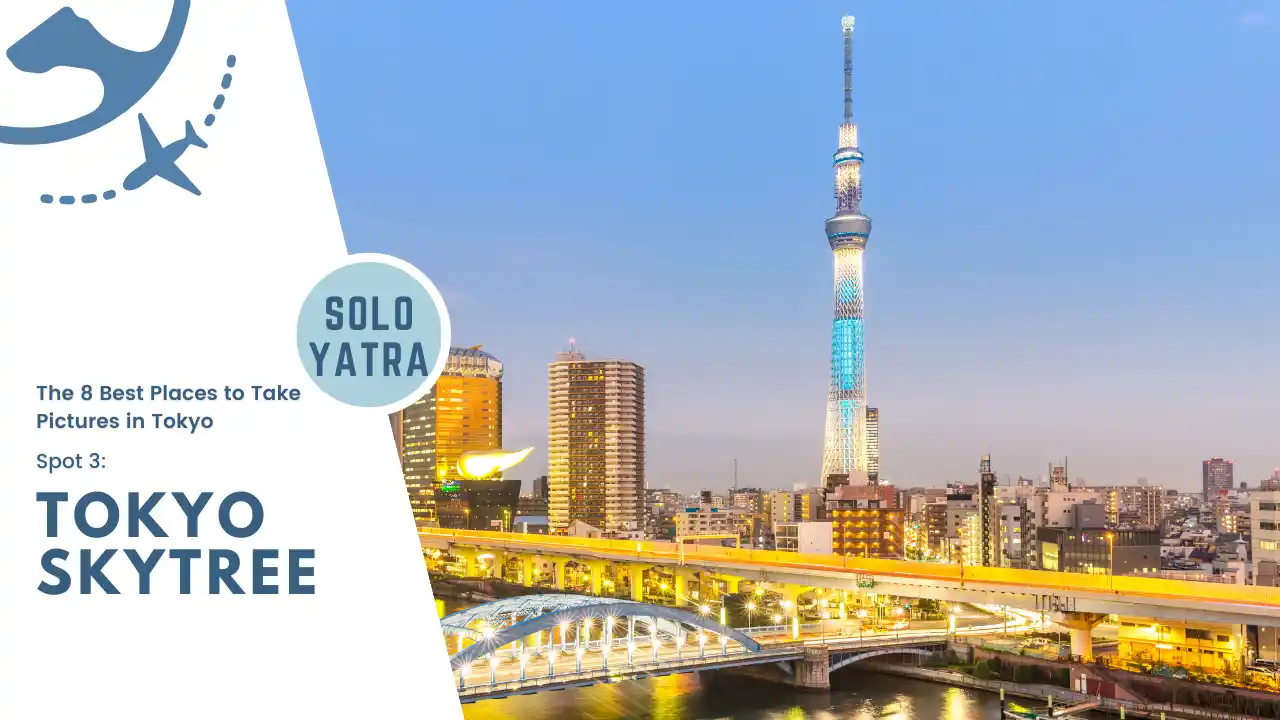
As one of Tokyo’s contemporary landmarks, the Tokyo Skytree offers photographers an incredible vantage point over the sprawling city. At 634 meters, it’s one of the world’s tallest towers. Views from the upper observation decks reveal Tokyo’s immense scale.
Purchase tickets to the upper observation deck at 450 meters for the best views. Compose wide shots, capturing the vast urban expanse stretching to the horizon in every direction. Try both horizontal formats to showcase the city’s spread as well as verticals to emphasize the tower’s towering height.
Don’t just take shots through the deck windows; also capture the towering structure itself. Photograph the intricate geometric patterns of the exterior latticework from different viewpoints and angles. A wide-angle lens emphasizes the tower’s height and sense of perspective.
For lower vantage points from the ground, head to the Skytree base or Solamachi shopping complex. Here, you can incorporate people in your shots to show scale. Try using slow shutter speeds, like 1/4 sec, to create streaking light trails of traffic flowing around the futuristic tower.
Aim for clear days for panoramic views. And go as late in the day as possible to capture the tower illuminated against the night sky. This is truly one of the best photo spots Tokyo has to offer.
Best For: Capturing panoramic city views and architectural details of a modern landmark.
Best Time to Visit
For the best views from Tokyo Skytree, aim for clear days when you can see the city stretching out in all directions. Late in the day is also a great time to visit, as you can capture the tower illuminated against the evening sky.
Best View
The upper observation deck at 450 meters offers panoramic views of the city. From here, you can compose wide shots that capture the vast urban expanse. Don’t forget to also capture the towering structure itself, with its intricate geometric patterns.
For lower vantage points, the base of the Skytree or the Solamachi shopping complex are great options. Here, you can incorporate people in your shots to show the scale of the tower.
Pro Tips
When photographing Tokyo Skytree, a wide-angle lens can help emphasize the tower’s height and sense of perspective. Experiment with different shutter speeds, like 1/4 sec, to create streaking light trails of traffic flowing around the tower.
Spot 4: Senso-ji Temple
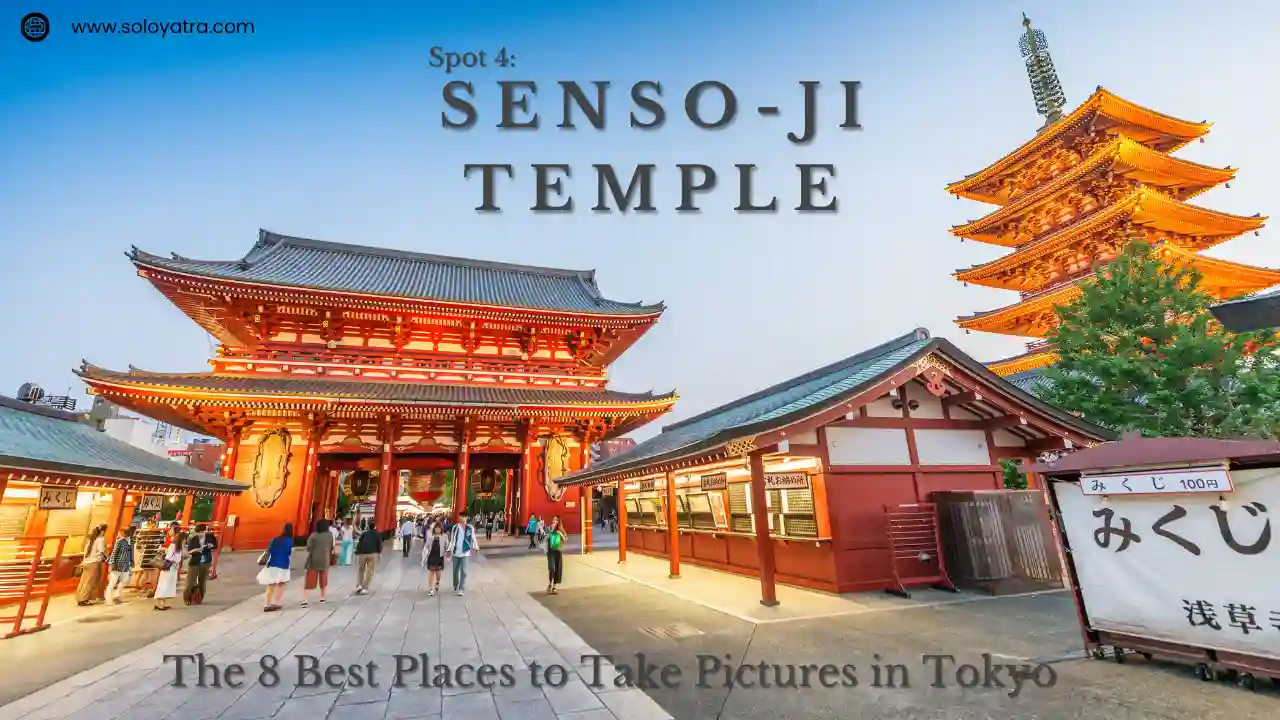
Senso-ji in Asakusa is Tokyo’s oldest and most renowned Buddhist temple, but also one of the best photo spots in Tokyo. The temple boasts vibrant vermilion structures and towering pagodas. The approach is lined with stalls bursting with traditional snacks and wares, creating an atmospheric scene.
Begin photographing at Kaminarimon Gate, the outer entrance gate along the Nakamise shopping street. Capture the intricate carvings and massive lantern overhead. Frame shots looking outward through the gate to create an intriguing sense of depth.
Moving inward, photograph the Five-Story Pagoda along with smoke wafting up from the incense cauldron in the foreground. A wide aperture, like f/4, renders the smoke in an ethereal way against the sharp lines of the pagoda.
At the main temple, compose shots of the Tahoto pagoda framed through the bright red columns. Shoot upward for an impressive perspective on the soaring roofline. Capture tourists praying and lighting incense to convey the timeless rituals.
Near closing time in the late afternoon, soft lighting illuminates the temple structures in a warm glow. Contrast this with the vibrant lantern lights illuminating the stalls at night.
For photography, weekdays are less crowded than weekends, when tourism peaks. But the energy of the crowds on weekends also provides captivating scenes of humanity.
Best For: Capturing the rich cultural heritage and serene atmosphere of Tokyo’s oldest temple.
Best Time to Visit
The best time to visit Senso-ji Temple is in the late afternoon, near closing time. This is when soft lighting illuminates the temple structures in a warm glow, creating a serene and captivating atmosphere.
Weekdays are less crowded, but the energy of the crowds on weekends also provides captivating scenes.
Best View
Start your photography journey at the Kaminarimon Gate, the outer entrance gate along the Nakamise shopping street. Moving inward, the Five-Story Pagoda and the main temple offer impressive views.
The bright red columns of the Tahoto pagoda and the soaring roofline of the main temple make for striking photos.
Pro Tips
When photographing Senso-ji Temple, consider using a wide aperture, like f/4, to render the smoke from the incense cauldron in an ethereal way against the sharp lines of the pagoda. Shoot upward for an impressive perspective on the soaring roofline.
Don’t forget to capture tourists praying and lighting incense to convey the timeless rituals.
Spot 5: Tokyo Imperial Palace
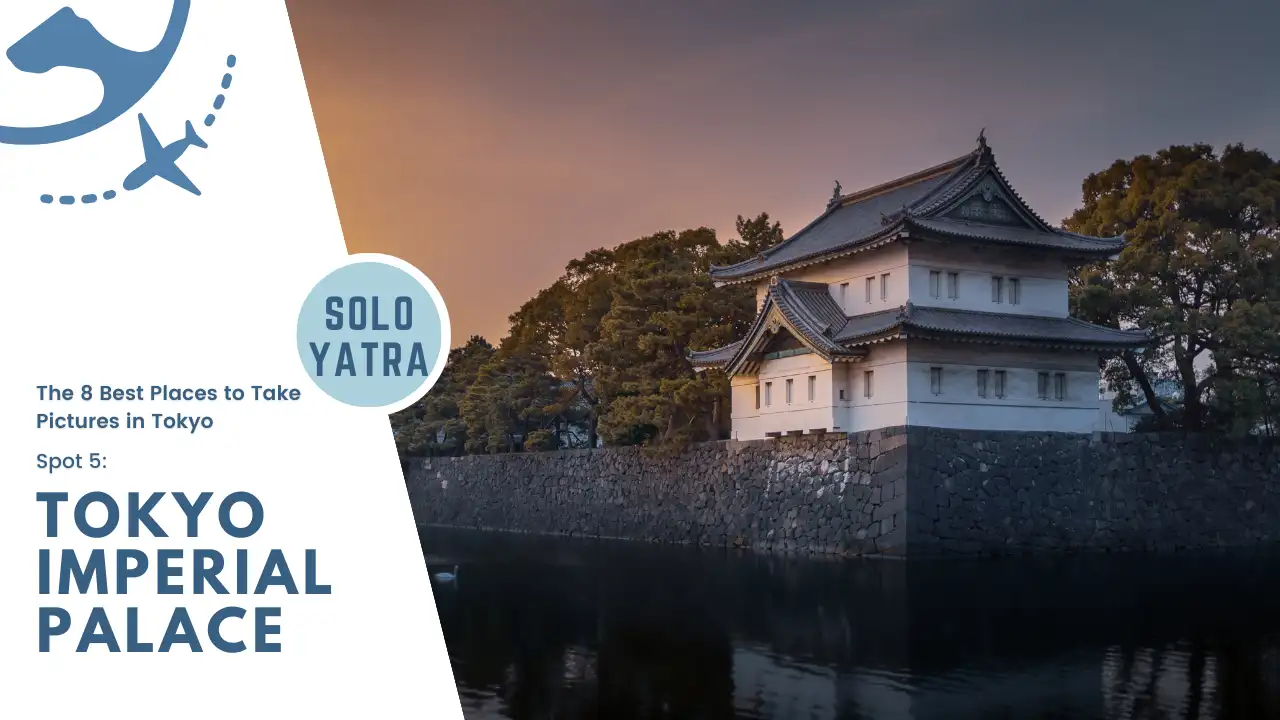
In the very heart of the city lies the Tokyo Imperial Palace, the residence of Japan’s imperial family. The palace grounds contain gorgeous parks and gardens that provide a tranquil escape from the surrounding skyscrapers.
The postcard shot is the Nijubashi bridge leading to the inner palace grounds. Frame the bridge symmetrically with the square towers reflected in the moat for a timeless image. Shoot from multiple angles along the waterfront path.
Stroll through the East Garden to photograph the meticulous traditional landscaping. Capture panoramas across the perfect lawns and you’ll feel worlds away from the city. Close-up details like flowing water or gnarled pine trees also make textured abstracts.
In cherry blossom season, the blooming trees create stunning contrasts of color and form. The sakura are lit up at night, allowing magical evening shots.
Aim for midweek visits when fewer crowds are present. Mornings often have clearer skies but afternoon illumination can be striking as well.
Best For: Capturing the serene beauty of traditional Japanese architecture and gardens amidst a bustling city backdrop.
Best Time to Visit
The Tokyo Imperial Palace is a sight to behold at any time of the day, but the mornings often have clearer skies, making it an ideal time for photography. Midweek visits are recommended when there are fewer crowds. During the cherry blossom season, the blooming trees lit up at night create a magical atmosphere.
Best View
The Nijubashi bridge leading to the inner palace grounds offers a timeless view. The bridge, framed symmetrically with the square towers reflected in the moat, makes for a perfect postcard shot.
The East Garden, with its meticulous traditional landscaping, offers panoramic views across the perfect lawns and close-up details like flowing water or gnarled pine trees.
Pro Tips
Experiment with shooting from multiple angles along the waterfront path. In the East Garden, capture panoramas across the lawns and close-up details for textured abstracts. During the cherry blossom season, the lit-up sakura at night allow for magical evening shots.
Spot 6: Odaiba Waterfront
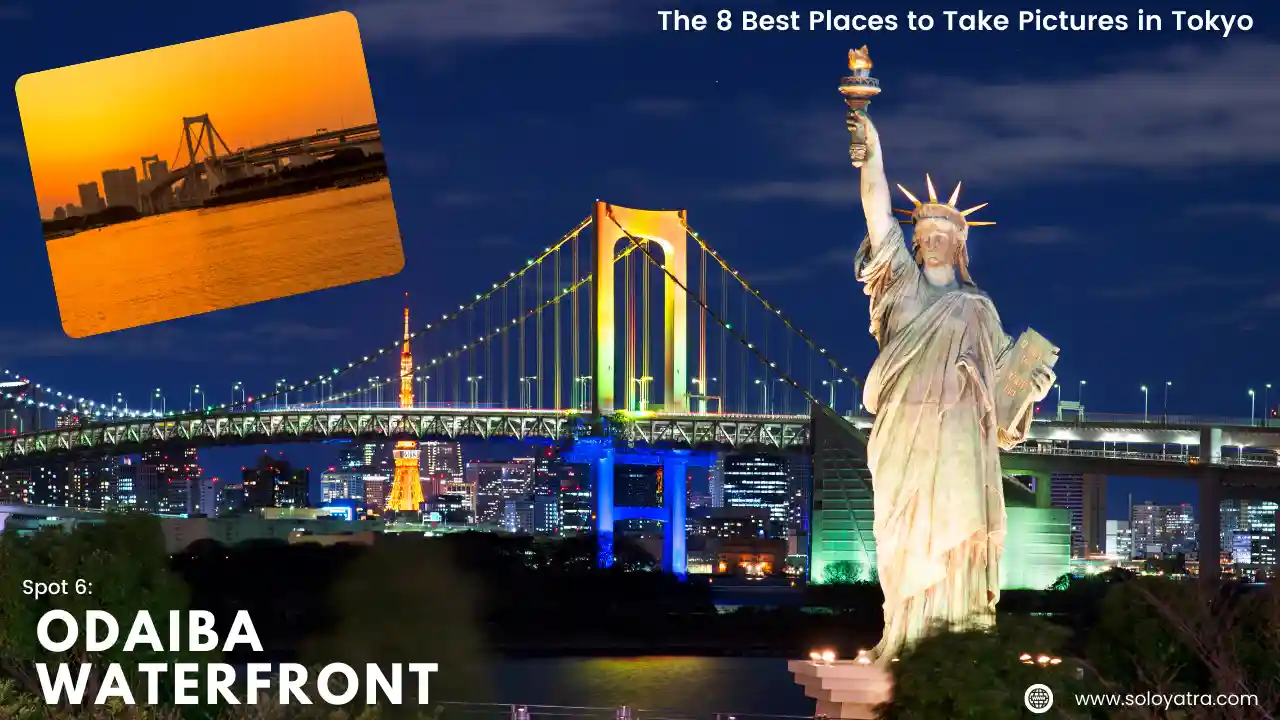
For contemporary cityscapes, head across the Rainbow Bridge to Odaiba, a reclaimed island in Tokyo Bay now filled with shopping malls and amusements. Photography hotspots here include Diver City Plaza, Decks Mall, and Odaiba Seaside Park.
Begin at Diver City to capture shots of the 18-meter-tall Gundam statue, based on the anime series. Photograph it standing tall amidst the gleaming buildings to show the intersection of pop culture and urban Japan. Try silhouetting it against the Tokyo skyline.
Walking north along the waterfront promenade, frame cityscape shots across the water to Tokyo proper. Incorporate pedestrians on bikes and scooters speeding along the path. Long exposure shots of traffic create light trails over the water.
End at Seaside Park for unobstructed panoramas looking back at the Tokyo skyline. Position yourself on the grass or white sands lining the water. Wait until sunset when the buildings and Ferris wheel light up in vibrant hues reflected on the water.
Best For: Capturing contemporary cityscapes, iconic structures, and stunning views of Tokyo Bay.
Best Time to Visit
Odaiba Waterfront is a vibrant destination at any time of the day. However, the evening hours offer a special charm with the city lights reflecting off the waters of Tokyo Bay, making it an ideal time for photography.
Best View
Start your journey at Diver City, where you can capture the 18-meter-tall Gundam statue against the backdrop of the city skyline. As you walk north along the waterfront promenade, frame cityscape shots across the water to Tokyo proper.
Finally, end at Seaside Park for unobstructed panoramas looking back at the Tokyo skyline.
Pro Tips
When photographing Odaiba Waterfront, consider using long exposure shots to create light trails of traffic over the water. Also, try to incorporate elements like pedestrians on bikes and scooters to add a dynamic touch to your photos.
Spot 7: Yoyogi Park

Yoyogi Park near Harajuku is a popular Tokyo gathering spot and photography hotspot thanks to its extensive lawns, ponds, and forested areas. It’s especially lively on weekends when people come to picnic, play music, and enjoy street performances.
Capturing the small scenes of life in the park reveals Tokyo’s youth culture. Photograph young musicians jamming, street fashion, and outdoor dance parties. Keep your eyes peeled for creative costumes and styles.
The ponds and paths also provide pretty scenery. Frame majestic willow trees reflected in the water for tranquil images. Japanese maples blaze red in autumn for a brilliant fall color.
For cityscapes, head to the edge of the park near Meiji Shrine. From a high vantage point, photograph the Shinjuku skyline rising above the treetops. Wait until dusk when the lights start sparkling to life.
Best For: Capturing the vibrant local culture, serene nature scenes, and stunning cityscapes.
Best Time to Visit
Yoyogi Park is most lively on Saturday and Sunday afternoons, making it an ideal time for photography. The park is filled with activity, and flashier styles tend to emerge later in the afternoon and evening. Autumn provides beautiful fall scenery, adding a vibrant touch to your photos.
Best View
Yoyogi Park offers a variety of views. The ponds and paths provide pretty scenery, with majestic willow trees reflected in the water and Japanese maples blazing red in autumn. For cityscapes, head to the edge of the park near Meiji Shrine.
From a high vantage point, you can photograph the Shinjuku skyline rising above the treetops.
Pro Tips
When photographing Yoyogi Park, keep your eyes peeled for small scenes of life that reveal Tokyo’s youth culture. Shoot candidly with a short telephoto lens like an 85mm prime to capture young musicians jamming, street fashion, and outdoor dance parties. Wait until dusk when the city lights start sparkling to life for a magical touch to your photos.
Spot 8: Takeshita Street
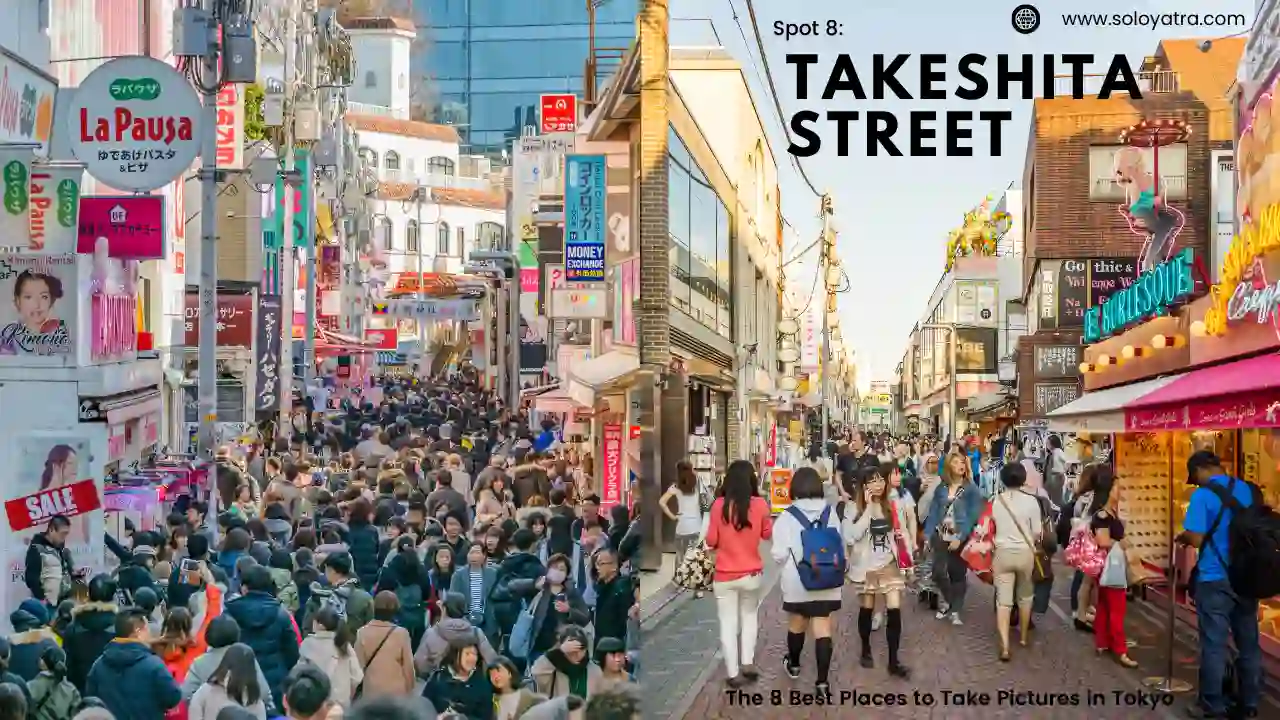
Just down the road from Yoyogi Park lies Takeshita Street in Harajuku, Tokyo’s famous fashion and youth culture hub. The narrow pedestrian street is packed with clothing boutiques, crepe stands, and pop culture shops, all brimming with bright colors and visual excitement.
To capture the vibrancy, compose shots looking down the street framed by the colorful shopfronts on both sides. Try vertical orientations as well. Capture locals sporting cutting-edge styles.
Get close-ups of the cute candy-colored crepes adorned with chocolate, fruit, and whipped cream swirls. The visual details tell the story of Harajuku’s playful fun-loving spirit.
Navigate the densely packed crowds by shooting from up high – second-story cafes provide elevated views. Or step into shops for unconventional interior angles peering out.
Visit on weekends when pedestrian traffic peaks. And don’t miss unique events like Halloween when costumes and cosplay abound.
Best For: Capturing the vibrant youth culture, eclectic fashion, and bustling energy of a trendy shopping street.
Best Time to Visit
Takeshita Street is most vibrant on weekends when pedestrian traffic peaks. This is when you can witness the street at its most lively, filled with locals sporting cutting-edge styles and unique events like Halloween when costumes and cosplay abound.
Best View
The narrow pedestrian street, packed with clothing boutiques, crepe stands, and pop culture shops, offers a colorful and visually exciting view. Get close-ups of the candy-colored crepes adorned with chocolate, fruit, and whipped cream swirls to capture the playful spirit of Harajuku.
Navigating the densely packed crowds by shooting from up high, such as from second-story cafes, provides elevated views.
Pro Tips
When photographing Takeshita Street, consider using a wider angle around 24mm to enhance the perspective. Try vertical orientations to capture the height of the buildings and the crowd. Don’t forget to step into shops for unconventional interior angles peering out.
Bonus Spot: Tsukiji Fish Market
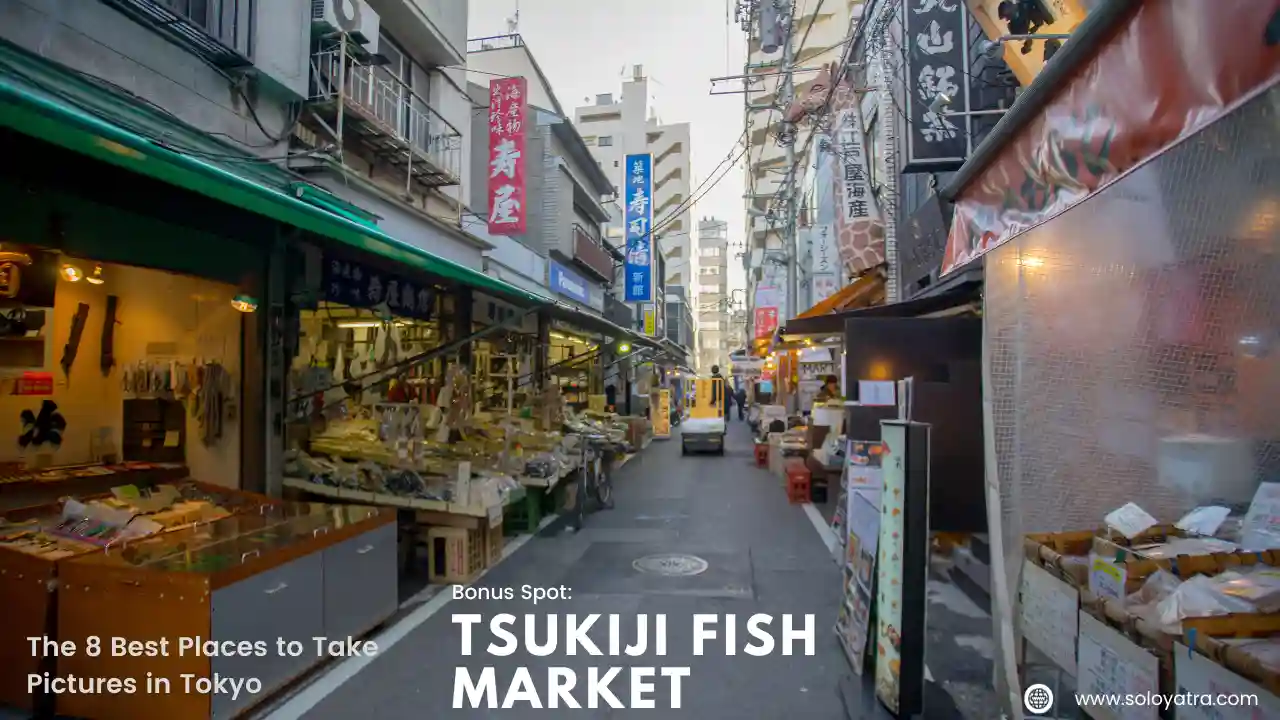
No photography tour of Tokyo is complete without visiting the renowned Tsukiji Fish Market. Although the inner auction market relocated in 2018, the outer retail market retains all of the chaotic energy and visual splendor.
Capture the dizzying array of seafood on display from all angles – Japanese tuna, giant crabs, and endless assortments of exotic species. Shoot details of tentacles, eyes, and scales to showcase diversity. Pop-up food stalls also make colorful scenes.
Include the market workers and buyers in your shots to convey life and motion. Seek people putting together intricate sushi platters for intimate scenes of craft.
Beyond the market, venture out to the surrounding warehouses and loading docks where forklifts offload fresh catches amidst weathered, graffiti-adorned walls. The gritty urban textures juxtapose the pristine seafood within.
Tsukiji perfectly encapsulates the bustling productivity that underlies Tokyo’s life. Don’t miss this iconic destination for one-of-a-kind market photography.
Best For: Capturing the bustling productivity of a renowned seafood market and the vibrant life that underlies Tokyo’s culture.
Best Time to Visit
The best time to visit Tsukiji Fish Market is early in the morning, around 9 am, when the action peaks. This is when you can witness the market at its most vibrant, filled with a dizzying array of seafood on display.
Best View
Tsukiji Fish Market offers a variety of views. From the colorful pop-up food stalls to the market workers and buyers, there’s always something interesting to capture. Venture out to the surrounding warehouses and loading docks for a different perspective, where the gritty urban textures juxtapose the pristine seafood within.
Pro Tips
When photographing Tsukiji Fish Market, consider using a wide angle like 16mm up close to portray the interactions of the market workers and buyers against the backdrops of food. Don’t forget to capture the details of the seafood to showcase its diversity.
Many people also search for romantic restaurants in Tokyo for a perfect night. Here are the 6 best romantic restaurants in Tokyo for a perfect night.
Where to Find the Best Tokyo Photo Spots
Finding the best photo spots in Tokyo involves a mix of exploring both its modern and traditional sides. Here are some general tips:
- Bustling Intersections: Look for busy intersections in the city. These places, especially when viewed from a height, can provide dynamic shots of the city’s hustle and bustle.
- Sacred Shrines: Tokyo is home to numerous shrines that offer a tranquil setting amidst the city chaos. The traditional architecture and serene surroundings of these places provide excellent photo opportunities.
- Towering Structures: Look for the tallest structures in the city. They often have observation decks that offer panoramic views of the cityscape.
- Historic Districts: Some districts retain the vibe of an older Tokyo. The traditional gates, temples, and old-world charm of these places are must-visit photo spots.
- Waterfront Areas: Waterfront areas, especially those with a view of bridges or the skyline across the bay, can offer stunning photo opportunities.
- Modern Districts: Some districts are known for their modern architecture and city lights. Observation decks in these areas can provide stunning night views of the city.
- Fashion Streets: Streets known for their vibrant fashion scene can offer colorful and quirky photo opportunities.
- Parks: During certain seasons, parks and areas around the city bloom with cherry blossoms or autumn leaves, offering beautiful natural backdrops for your photos.
Remember, the best photo spots often require a bit of exploration and patience.
Conclusion: Mastering Tokyo Photography
I hope this detailed guide to the top Tokyo photography locations, which are some of the best photo spots in Tokyo, helps you capture this amazing city, wherever your interests may lie. The key is going at the right times, having the proper gear, and applying different perspective techniques to compose unique shots.
Patience is also required to wait for that perfect moment of light, motion, or human interaction. Tokyo offers boundless energy and beauty for photographers who take the time to explore its hidden gems and popular hotspots.
Now that you know the best places in Tokyo for photography and the best photo spot in Tokyo, get out and start shooting! Absorb the city’s one-of-a-kind ambiance, a fascinating mix of old and new, and the lovely Japanese people that make this such an incredible photographic muse.
People Also Ask (FAQs)
Q) How to spend 8 hours in Tokyo?
A) Here are some ideas for spending 8 hours in Tokyo:
- Start your day in Shibuya – see the famous Shibuya Crossing, visit Meiji Jingu Shrine, and do some shopping and people-watching in the vibrant neighborhoods.
- Head to Asakusa in the afternoon – walk through Senso-ji Temple, browse the stalls along Nakamise Shopping Street, and sample street food.
- Finish up in Shinjuku – go up to the Tokyo Metropolitan Government Building for free panoramic views, explore the neon-lit Kabukicho area, and have an amazing dinner.
- Take the train between locations – Tokyo’s transit system makes it easy to maximize your time.
Q) What is the most photographed street in Tokyo?
A) The most photographed street in Tokyo is Takeshita Street in Harajuku. Located near Meiji Jingu Shrine, Takeshita Street is famous for its youth culture, fashion boutiques, crepe stands, and cafes. The colorful shops, stylish pedestrians, and lively atmosphere make it a popular spot for photos.
Q) What is the nicest area in Tokyo?
A) Some of the nicest areas in Tokyo include:
- Shinjuku Gyoen – a large, beautiful park with gardens, walkways, and cherry blossoms in spring.
- Asakusa – with historic temples, a traditional vibe, and great shops and restaurants.
- Odaiba – a modern entertainment district along Tokyo Bay with shopping malls, restaurants, and a Ferris wheel.
- Roppongi Hills – an upscale area with shopping, contemporary architecture, and Mori Art Museum.
- Ginza – Tokyo’s high-end shopping district with luxury brands and department stores.
Q) What is the most famous picture in Japan?
A) Some of Japan’s most famous pictures include:
- The Great Wave off Kanagawa – Hiroshige’s woodblock print of a giant wave threatening boats at sea.
- Geisha in Gion – A geisha walking through the Gion district in Kyoto, captured by Carl Van Vechten in the 1930s.
- Shibuya Crossing – World famous intersection with hundreds of pedestrians at a time.
- Mount Fuji paintings – Iconic depictions of Japan’s tallest peak by artists like Hokusai.
- Atomic bomb mushroom cloud – Photographs of the Hiroshima and Nagasaki bombings at the end of WWII.
Q) How much money do I need for 7 days in Japan?
A) For 7 days in Japan, you’ll probably need around 100,000 to 150,000 yen ($700-$1,000 USD). This covers basic accommodation, local transportation, reasonably priced food, sightseeing, and some shopping. You can spend more or less depending on your preferences. Japan offers a range of accommodation and dining options at various price points. Budget carefully and withdraw cash in Japan as needed to stick to your spending goals.

